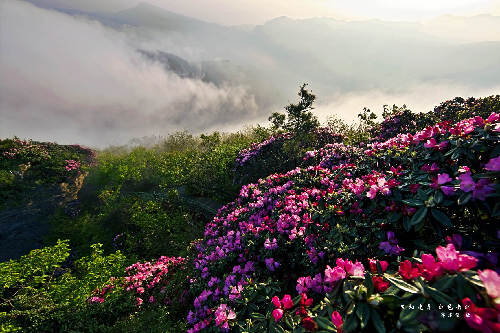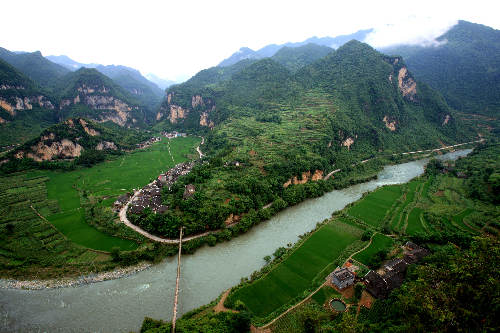Bazhong – A City of Tranquility and Beauty
Many people favor single adjectives to describe different mountains, for example, “elegant” for Mount Emei, “strange” Zhangjiajie National Forest Park, and “dangerous” Mount Hua; Guangwu Mountain, however, is noted for its range of peculiar peaks, bizarre rocks and secluded valleys. If one appreciates the pines on Huangshan Mountains, worships the heavens at Taishan Mountain, and prays at Mount Jiuhua, what does one do at Guangwu Mountain? Watch the clouds and mist? One would love to remain immersed in the wonderland of cloud and mist all about. But after the clouds melt and the mists disperse, the red autumnal leaves all over the mountains take your breath away.

Rhododendrons blossom on Guangwu Mountain.
|
 |
| The densely forested Kongshan Scenic Area. |
If only one word could be used to describe Guangwu Mountain, we think it should be “noble,” for its flamboyant scenery and integral history.
The most beautiful view has to be the blurred and hazy mists arising from treetops and merging into the clouds. Throughout the four seasons, the mountain is covered in cloud and mist: sometimes resembling a delicate fairy wandering about at leisure, or wide sleeves entwining the mountainsides, at other times like wrapping paper fully swaddling the summit, or a coy maid veiling half of the peak in jest.
As with other mountains, sceneries change with each season. In spring, mountain flowers are in full bloom, and in summer the trees offer pleasant shade. Late autumn features bright leaves as if on fire. And in cold winter, the mountain and trees of ice and snow resemble a world of jade and silver. Nevertheless, there is one difference from other mountains, especially in the spring: flowers on the mountain do not bloom in profusion, but blossom gradually based on different altitudes. Often, when flowers at the foot are in full blossom, flowers at the top are just in bud.
Services
Economy
- Are You Ready to Perform?
- Beijing’s Green Courtyard
- China’s CSR on the Global Market Fast Track – An Interview with Xu Zongxiang, vice president of China South Locomotive & Rolling Stock Corporation Limited (CSR)
- China’s Changing Development Pattern
- China Accelerates Transformation of Its Economic Development Model
